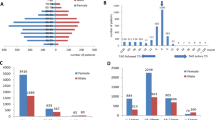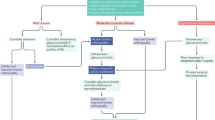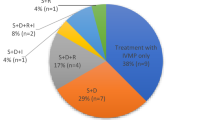Abstract
Management of Graves' ophthalmopathy is preferably done in a multidisciplinary setting. Smoking is associated with worse disease outcome. 131I therapy for hyperthyroidism can also worsen ophthalmopathy, especially if administered during active disease or to patients who smoke or have severe hyperthyroidism, or those with high levels of TSH-receptor-binding inhibitory immunoglobulins. Coadministration of steroids and 131I therapy is recommended for such high-risk patients. 131I therapy is safe for patients with inactive Graves' ophthalmopathy. Subtotal thyroidectomy and antithyroid drugs show no benefit or harm to eye changes. There is no good evidence that total thyroid ablation has additional benefit. Artificial teardrops, dark glasses and prisms are very helpful. Dysthyroid optic neuropathy is best treated with intravenous pulsed methylprednisolone; if visual functions do not recover, urgent surgical decompression is indicated. A wait-and-see policy is recommended in mild Graves' ophthalmopathy because the natural history of this condition reveals a tendency to resolve spontaneously. Active, moderately severe Graves' ophthalmopathy qualifies for immunosuppression: intravenous pulsed methylprednisolone is more efficacious and has fewer side effects than oral steroids. Once the disease is inactive, rehabilitative surgery has much to offer. Quality of life is seriously limited in patients with Graves' ophthalmopathy, and remains restricted even after all treatments. Consequently, there is an urgent need for improved treatment modalities, and antibody therapy has shown promise in this respect.
Key Points
-
Management of Graves' ophthalmopathy should be tailored to the individual patient's needs, but requires assessments of smoking behavior, thyroid function, and the severity and activity of the eye changes
-
Cessation of smoking is useful in the primary, secondary and tertiary prevention of Graves' ophthalmopathy
-
Treatment of Graves' hyperthyroidism with antithyroid drugs or subtotal or near-total thyroidectomy has no risk or benefit with respect to Graves' ophthalmopathy, but 131I therapy carries a small risk of development or worsening of eye changes
-
Mild Graves' ophthalmopathy is best managed by a 'wait-and-see' policy or retrobulbar irradiation, whereas dysthyroid optic neuropathy should be treated urgently with intravenous pulsed methylprednisolone
-
Active, moderately severe Graves' ophthalmopathy qualifies for immunosuppression; the efficacy and tolerability of intravenous pulsed methylprednisolone are better than those of high-dose oral prednisone
-
Rehabilitative surgery (in the sequence orbital decompression, eye-muscle surgery, eyelid surgery) should be considered in patients who have residual eye changes once Graves' ophthalmopathy has become inactive
This is a preview of subscription content, access via your institution
Access options
Subscribe to this journal
Receive 12 print issues and online access
$209.00 per year
only $17.42 per issue
Buy this article
- Purchase on Springer Link
- Instant access to full article PDF
Prices may be subject to local taxes which are calculated during checkout



Similar content being viewed by others
References
Brokken LJ et al. (2003) Thyrotropin receptor autoantibodies are associated with continued thyrotropin suppression in treated euthyroid Graves' disease. J Clin Endocrinol Metab 88: 4135–4138
Gerding MN et al. (2000) Association of thyrotropin receptor autoantibodies with the clinical features of Graves' ophthalmopathy. Clin Endocrinol 52: 267–271
Eckstein AK et al. (2004) Clinical results of anti-inflammatory therapy in Graves' ophthalmopathy and association with thyroidal autoantibodies. Clin Endocrinol 61: 612–619
Eckstein AK et al. (2006) TSH-receptor autoantibodies are independent risk factors for Graves' ophthalmopathy and help to predict severity and outcome of the disease. J Clin Endocrinol Metab 91: 3464–3470
Khoo DHC et al. (1999) The combination of absent thyroid peroxidase antibodies and high thyroid-stimulating immunoglobulin levels in Graves' disease identifies a group at markedly increased risk of ophthalmopathy. Thyroid 9: 1175–1180
The European Group on Graves' Orbitopathy (EUGOGO) (2006) Clinical assessment of patients with Graves' orbitopathy: the European Group on Graves' Orbitopathy recommendations to generalists, specialists and clinical researchers. Eur J Endocrinol 155: 387–389
Dickinson AJ and Perros P (2001) Controversies in the clinical evaluation of active thyroid associated orbitopathy: use of a detailed protocol with comparative photographs for objective assessment. Clin Endocrinol 55: 283–303
Farid M et al. (2005) Psychological disturbance in Graves' ophthalmopathy. Arch Ophthalmol 123: 491–496
Kahaly GJ et al. (2005) Psychosocial morbidity of Graves' orbitopathy. Clin Endocrinol 63: 395–402
EUGOGO European Group on Graves' Orbitopathy [www.eugogo.org] (accessed 8 March 2007)
Terwee CB et al. (2001) Interpretation and validity of changes in scores on the Graves' ophthalmopathy quality of life questionnaire (GO-QoL) after different treatments. Clin Endocrinol 54: 391–398
Wiersinga WM (2005) The philosophy of Graves' ophthalmopathy. Orbit 24: 165–171
Prummel MF and Wiersinga WM (1993) Smoking and risk of Graves' disease. JAMA 269: 479–482
Krassas GE et al. (2005) Childhood Graves' ophthalmopathy: results of a European questionnaire study. Eur J Endocrinol 153: 515–521
Bartalena L et al. (1998) Cigarette smoking and treatment outcomes in Graves' ophthalmopathy. Ann Intern Med 129: 632–635
Eckstein A et al. (2003) Impact of smoking on the response to treatment of thyroid associated ophthalmopathy. Br J Ophthalmol 87: 773–776
Pfeilschifter J and Ziegler R (1996) Smoking and endocrine ophthalmopathy: impact of smoking severity and current vs lifetime cigarette consumption. Clin Endocrinol 45: 477–481
Krassas GE and Wiersinga WM (2006) Smoking and autoimmune thyroid disease: the plot thickens. Eur J Endocrinol 154: 777–780
Wiersinga WM and Bartalena L (2002) Epidemiology and prevention of Graves' ophthalmopathy. Thyroid 12: 855–860
Prummel MF et al. (1990) Effect of abnormal thyroid function on the severity of Graves' ophthalmopathy. Arch Intern Med 150: 1098–1101
Tallstedt L et al. (1992) Occurrence of ophthalmopathy after treatment for Graves' hyperthyroidism. N Engl J Med 326: 1733–1738
Bartalena L et al. (1998) Relation between therapy for hyperthyroidism and the course of Graves' ophthalmopathy. N Engl J Med 338: 73–78
Gorman CA (1995) Radioiodine therapy does not aggravate Graves' ophthalmopathy. J Clin Endocrinol Metab 80: 340–341
Tallstedt L et al. (1994) Does early administration of thyroxine reduce the development of Graves' ophthalmopathy after radioiodine treatment? Eur J Endocrinol 130: 494–497
Törring O et al. (1996) Graves' hyperthyroidism: treatment with antithyroid drugs, surgery, or radioiodine—prospective, randomized study. J Clin Endocrinol Metab 81: 2986–2993
Perros P et al. (2005) A prospective study of the effects of radioiodine therapy for hyperthyroidism in patients with minimally active Graves' ophthalmopathy. J Clin Endocrinol Metab 90: 5321–5323
Jensen BE et al. (2005) Glucocorticoids do not influence the effect of radioiodine therapy in Graves' disease. Eur J Endocrinol 153: 15–21
Marcocci C et al. (1999) The course of Graves' ophthalmopathy is not influenced by near-total thyroidectomy: a case–control study. Clin Endocrinol 51: 503–508
Järhult J et al. (2005) Graves' disease with moderate–severe endocrine ophthalmopathy—long term results of a prospective, randomized study of total or subtotal thyroid resection. Thyroid 15: 1157–1164
Moletti M et al. (2003) Effects of thyroidectomy alone or followed by radioiodine ablation of thyroid remnants on the outcome of Graves' ophthalmopathy. Thyroid 13: 653–658
Ravzi S et al. (2006) What is the evidence behind the evidence-base? The premature death of block-replace antithyroid drug regimens for Graves' disease. Eur J Endocrinol 154: 783–786
Perros P et al. (1995) Natural history of thyroid associated ophthalmopathy. Clin Endocrinol 42: 45–50
Mourits MP et al. (2000) Radiotherapy for Graves' orbitopathy; randomized placebo-controlled study. Lancet 355: 1505–1509
Prummel MF et al. (2004) A randomized controlled trial of orbital radiotherapy versus sham irradiation in patients with mild Graves' ophthalmopathy. J Clin Endocrinol Metab 89: 15–20
Wiersinga WM (1996) Advances in medical therapy of thyroid-associated ophthalmopathy. Orbit 15: 177–186
Gerding MN et al. (2000) Assessment of disease activity in Graves' ophthalmopathy by orbital ultrasonography and clinical parameters. Clin Endocrinol 52: 641–646
Lazarus JH et al. (2006) Clinical features of dysthyroid optic neuropathy: a European Group on Graves' Orbitopathy (EUGOGO) survey. Br J Ophthalmol [doi: 10.1136/bjo.2006.094607]
Kalmann R and Mourits MP (1999) Diabetes mellitus: a risk factor in patients with Graves' orbitopathy. Br J Ophthalmol 83: 463–465
Wakelkamp IMMJ et al. (2005) Surgical or medical decompression as a first line treatment of optic neuropathy in Graves' ophthalmopathy? A randomized controlled trial. Clin Endocrinol 63: 323–328
Kahaly GJ et al. (2000) Low- versus high-dose radiotherapy for Graves' ophthalmopathy: a randomized single blind trial. J Clin Endocrinol Metab 85: 102–108
Gerling J et al. (2003) Retrobulbar irradiation for thyroid associated orbitopathy: double blind comparison between 2.4 and 16 Gy. Int J Radiat Oncol Biol Phys 55: 182–189
Marcocci C et al. (2003) Long-term safety of orbital radiotherapy for Graves' ophthalmopathy. J Clin Endocrinol Metab 88: 3561–3566
Wakelkamp IMMJ et al. (2004) Orbital irradiation for Graves' ophthalmopathy. Is it safe? A long-term follow-up study. Ophthalmology 111: 1557–1562
Prummel MF et al. (1989) Prednisone and cyclosporine in the treatment of severe Graves' ophthalmopathy. N Engl J Med 321: 1353–1359
Kahaly G et al. (1996) Randomized trial of intravenous immunoglobulins versus prednisone in Graves' ophthalmopathy. Clin Exp Immunol 106: 197–202
Prummel MF et al. (1993) Randomized double-blind trial of prednisone versus radiotherapy in Graves' ophthalmopathy. Lancet 342: 949–954
Gorman CA et al. (2001) A prospective randomized, double-blind, placebo-controlled study of orbital radiotherapy for Graves' ophthalmopathy. Ophthalmology 108: 1523–1534
Wémeau JL et al. (2005) Octreotide (long-acting release formulation) treatment in patients with Graves' orbitopathy: clinical results of a four-month, randomized, placebo-controlled, double-blind study. J Clin Endocrinol Metab 90: 841–848
Dickinson JA et al. (2004) Double-blind, placebo-controlled trial of octreotide long-acting release (LAR) in thyroid-associated ophthalmopathy. J Clin Endocrinol Metab 89: 5910–5915
Chang T-C and Lino S-L (2006) Slow-release lanreotide in Graves' opthalmopathy: a double blind, randomized, placebo-controlled clinical trial. J Endocrinol Invest 29: 413–422
Stan MN et al. (2006) Randomized, double-blind, placebo-controlled trial of long-acting release octreotide for treatment of Graves' ophthalmopathy. J Clin Endocrinol Metab 91: 4817–4824
Marcocci C et al. (1991) Orbital radiotherapy combined with high dose systemic glucocorticoids for Graves' ophthalmopathy is more effective than radiotherapy alone: results of a prospective randomized study. J Endocrinol Invest 14: 853–860
Kahaly G et al. (1986) Cyclosporin and prednisone vs prednisone in treatment of Graves' ophthalmopathy: a controlled, randomized and prospective study. Eur J Clin Invest 16: 415–422
Marcocci C et al. (2001) Comparison of the effectiveness and tolerability of intravenous or oral glucocorticoids associated with orbital radiotherapy in the management of severe Graves' ophthalmopathy: results of a prospective, single-blind, randomized study. J Clin Endocrinol Metab 86: 3562–3567
Kahaly GJ et al. (2005) Randomized, single blind trial of intravenous versus oral steroid monotherapy in Graves' orbitopathy. J Clin Endocrinol Metab 90: 5234–5240
Kauppinen-Mäkelin R et al. (2002) High dose intravenous methylprednisolone therapy versus oral prednisone for thyoid-associated ophthalmopathy. Acta Ophthalmol Scand 80: 316–321
Ohtsuka K et al. (2003) Effect of steroid pulse therapy with and without orbital radiotherapy on Graves' ophthalmopathy. Am J Ophthalmol 135: 285–290
Weissel M and Hauff W (2000) Fatal liver failure after high-dose glucocorticoid pulse therapy in a patient with severe thyroid eye disease [letter]. Thyroid 10: 521
Marino M et al. (2004) Acute and severe liver damage associated with intravenous glucocorticoid pulse therapy in patients with Graves' ophthalmopathy. Thyroid 14: 403–406
Salvi M et al. (2004) Onset of autoimmune hepatitis during intravenous therapy for thyroid-associated ophthalmopathy in a patient with Hashimoto's thyroiditis: case report. Thyroid 14: 631–634
LeMoli R et al. Determinants of liver damage associated with intravenous methylprednisolone pulse therapy in Graves' ophthalmopathy. Thyroid, in press
Boulos PR and Hardy I (2004) Thyroid-associated orbitopathy: a clinicopathologic and therapeutic review. Curr Opin Ophthalmol 15: 389–400
Bartley GB et al. (1996) Long-term follow-up of Graves' ophthalmopathy in an incidence cohort. Ophthalmology 103: 956–962
Finamor FE et al. (2004) Pentoxiphylline (PTX)—an alternative treatment in Graves' ophthalmopathy (inactive phase): assessment by a disease specific quality of life questionnaire and by exopthalmometry in a prospective randomized trial. Eur J Ophthalmol 14: 277–283
Paridaens D et al. (2005) The effect of etanercept on Graves' ophthalmopathy: a pilot study. Eye 19: 1286–1289
Salvi M et al. (2007) Treatment of Graves' disease and associated ophthalmopathy with the anti-CD20 monoclonal antibody rituximab: an open study. Eur J Endocrinol 156: 33–40
Author information
Authors and Affiliations
Corresponding author
Ethics declarations
Competing interests
The author declares no competing financial interests.
Rights and permissions
About this article
Cite this article
Wiersinga, W. Management of Graves' ophthalmopathy. Nat Rev Endocrinol 3, 396–404 (2007). https://doi.org/10.1038/ncpendmet0497
Received:
Accepted:
Issue Date:
DOI: https://doi.org/10.1038/ncpendmet0497
This article is cited by
-
Machine learning-assisted system using digital facial images to predict the clinical activity score in thyroid-associated orbitopathy
Scientific Reports (2022)
-
Acute liver damage following intravenous glucocorticoid treatment for Graves’ ophthalmopathy
Endocrine (2016)
-
Management of patients in a combined thyroid eye clinic in secondary care
International Ophthalmology (2014)



